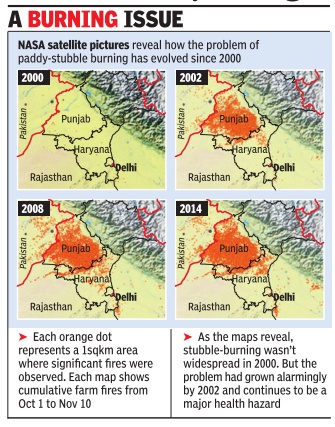Crop stubble burning: India
This is a collection of articles archived for the excellence of their content. |
Burning rice stubble
Amit Bhattacharya The Times of India, Nov 03 2015

Widespread crop burning began over dozen yrs ago
Satellite images reveal age-old norm
The practice of burning paddy stubbles in Punjab and Haryana has of late been recognised as a major contributor to air pollution in the national capital region during October-November. Satellite images, however, reveal that the problem had already reached alarming proportions as early as 13 years ago. Farm fires in the region began to register in satellite images in year 2000. Not that stubble burning did not take place before that, but the practice probably became widespread enough in 2000 for it to show up in the 1-square-km resolution satellite images. By 2002, the `fires spots' in the satellite pictures had filled up almost the entire state of Punjab and parts of northern Haryana.
TOI obtained the data from Nasa's FIRMS Fire Mapper website, which enables users to access satellite imagery from the past.
To get a season-wide picture perspective, cumulative fire data was considered from October 1 to November 10 -a 40-day period when farmers in the region burn their paddy stubble to prepare the fields for the next crop.
What the information reveals is that successive governments in the states have failed to check the practice despite a law that bans stubbleburning. The problem assumes more serious proportions with each passing year due to the fact that pollution from other sources are on the rise in NCR. So, the added pollutants that come from biomass burning make the situation graver.
The concentration of farm fires in Punjab and northern Haryana shows the extremely high proportion of farmers opting to grow paddy during the kharif season. As Ruby Singh Sandhu, a big farmer from Mallekan village in northern Haryana puts it, “Farmers in the cotton growing areas of Punjab and Haryana have been slowly shifting to paddy for more than a decade now.“
Did mechanical harvesting start the epidemic?
Chandigarh:
The advent of combine harvesters in Punjab, Haryana and UP, in the late 1980s and early 1990s, is being blamed for the practice of burning crop stubble. To save time and money, as well as to tackle labour shortage, more and more farmers are opting for mechanical harvesting of crops using combine harvesters.
Farmers say the blades of combine harvesters don't cut the crops close to the ground, and leaves the plant stalk, usually up to two feet high, standing.
Sarabjit Singh, a farmer from Virpur village of Bijnor district in UP , said the people who operate combine harvesters don't cut the crop close to the ground since they are more concerned about getting the grain. “The operators try to clear the maximum possible area in a day since they charge per acre. Hence, they leave the task of clearing the crop to the farmers. The crop stalk is very high at times,“ he added.
Farmers find it difficult to plough the crop residue back into the soil using harrows and, instead, resort to burning the stubble to clear the fields for the next crop. The problem is more pronounced in the winter, with little time available for farmers to prepare the fields for sowing wheat after harvesting paddy.
The prevailing rates for harvesting paddy using combine harvesters in north India are in the range of Rs 1,300-1,500 per acre. On the other hand, labour charges of harvesting paddy manually are around Rs 1,600 per acre, a practice more prevalent in UP, MP and parts of Haryana.
Another farmer, Baljinder Singh Sidhu from Kotbhara vil lage in Punjab's Bathinda district, said the days of manual harvesting were better: “Earlier, when paddy was manually harvested, the crop was cut close to the ground. While the grain was obtained after threshing, the leftover plant stalk or straw was stored as fodder for cattle.“
Sadhu Singh, director of Akhtiar Agro King, an agriculture machinery manufacturing unit in Moga, said the problem was acute in Punjab since the farmers don't consider paddy straw to be of any use.
“In case of wheat, the combine harvesters usually cut the crop close to the surface. However, farmers in Punjab don't keep paddy straw, so they don't insist on a close cut for the crop,“ he added.